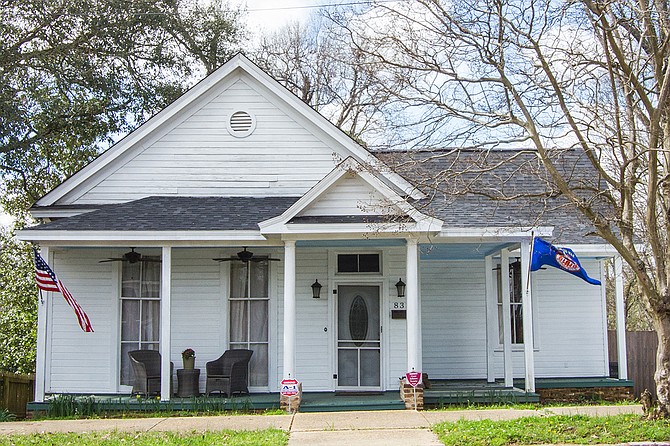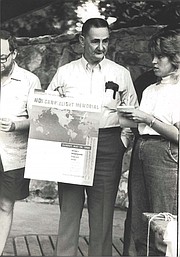The Sandifer House offered those who were HIV- and AIDS-positive respite from the stigma related to the diseases. The house closed in 1992. Photo by Stephen Wilson.
The urns weren't memorials. They were storage. They were the remains family members did not wish to acknowledge. They were the ashes of dying men who returned to Mississippi to live out their lives, only to discover their families would not permit anyone living with AIDS, even kinfolk, into their homes.
The sick came from New York, Los Angeles and Dallas, the larger urban centers where the scourge first took hold. Prejudice drove relatives to close their doors. Landlords and neighborhood associations did the same, denying residency to those struck with the enigmatic incipient disease called AIDS.
The Sandifer House, named after the late civil- and gay-rights advocate Eddie Sandifer, rose from this environment. Opening in 1987, the Sandifer House on Jefferson Street offered men and women living with the disease respite from the continuing stigma of being HIV-positive in the early years of the AIDS crisis.
It was at the Sandifer House where Jackson's gay community provided services to their own—filling needs larger societal institutions like government, hospital and family failed to address.
From Robbery to Vigils
"We all figured HIV would come to Jackson eventually," the late Eddie Sandifer said from a rocking chair in his one-story south Jackson home in 2016. For six decades, the brazen activist donated his energy to civil-rights activism, conventional and not. Sandifer even robbed jewelry stores in the 1960s to help fund civil-rights organizations, earning himself time in Parchman for the crimes.
"My radicalism has gotten me in a lot more trouble than my being gay," he said. Sandifer formed the now-defunct Jackson branch of the Gray Panthers advocacy group for senior citizens and often married same-sex couples in unofficial ceremonies throughout the 1970s and 1980s. Providing direct services to those in need was his specialty, one Sandifer honed as a nursing-home administrator for 20 years. He also became the director of the Mississippi Gay and Lesbian Alliance in 1974.
When the weekly gay-interest publication from the alliance, This Month in Mississippi, mentioned expanding cases of the new and fatal HTLV-3 virus killing off young men-having-sex-with-men, often called MSM, in New York and San Francisco, Sandifer knew Jackson had to be prepared. The 1980s continued an era of free love in the gay community, where promiscuity represented pride in who they were. If the disease did in fact spread through sex, it did so quickly. Those native Mississippians who contracted HIV elsewhere would return home to live out the rest of their lives.
"At least for a particular amount of time, people felt more protected in the smaller cities of the South," Dr. Jeffrey Kelly, a clinical psychologist and one of the first doctors to treat AIDS cases in Mississippi, said, "but it obviously wasn't true."
Kelly was on staff at the University of Mississippi Medical Center when the first known HIV-positive patient arrived in Mississippi. That patient survived only a few days, but by 1985, more Mississippi natives living with HIV were returning and finding themselves without a home here.
"There was paranoia and hysteria around HIV then and not many effective community responses were happening outside of the gay community here," Kelly said. Families shunned those infected, the government was silent, and at the time, UMMC was weary of becoming known as "the AIDS hospital," he said.
"I think the gay community realized they had to provide their own answer."
The first line of Sandifer House's mission statement promises "to provide a group home for the support and care of persons living with AIDS that have no other appropriate housing options."
MGLA rented a large white Belhaven Heights home around 1986 with help from private donors like Levi Strauss Co., which operates a factory in Canton. Sandifer's partner of more than 30 years, Steven Ray, who is known as Chris, said they even received donations and support from some City and State leaders. Twelve people occupied the house at a given time. They shared rooms, and when one resident passed, another filled the vacancy quickly.
The residents were young, 20s and 30s (some older), and mostly men. Many first encountered Sandifer as his car ambled up their driveway to provide transportation to UMMC or other facilities for testing or to the Sandifer House for long-term housing. The pick-ups occurred in the discrete dark of night, so as to not tip off family members and neighbors to any association with the stigmatized illness.
"The neighbors threatened to burn down one person's home south of Meridian when they found out he was positive," Sandifer said.
By day, he worked at a desk near the house's front entrance while the gaunt residents passed time playing cards, watching television and cooking.
"They were close. They became family, most of them," Sandifer said.
When a resident's condition grew dire, it was up to him and the other residents, those well enough to assist, to tend to them. They picked up medication, cleaned up diarrhea, called ambulances. Ray estimates that it cost $5,000 a month to operate the house, a constant expense that the local gay community helped cover. He says the house required ongoing maintenance—he recalls doing plumbing work in the dead of winter. At Jack and Jill's Tavern (now closed), owner Jack Myers charged an extra cover for years, with all proceeds going to MGLA.
The gay bars were the communal gathering spaces for a grieving community. Jack and Jill's main room held cigarette-lighter vigils almost every week. It was difficult to find anyone in the gay community whose inner circle was not affected by AIDS back then.
"I lost a lot of friends," Myers said. Jack and Jill's donated $15,000 to the Sandifer House from 1985 until 1992, without which Sandifer said the house could not have functioned. No government agency at the local, state or national level provided funding.
'Not All Gloom and Doom'
MGLA provided meals and maintenance, though local churches and other groups such as Wells United Methodist Church would serve or bring meals. Priscilla Pearson was both a Wells Methodist volunteer and a neighbor in Belhaven Heights.
"Everyone referred to it as 'The AIDS House,'" Pearson said. "Inside was kind of a hushed setting. A sense of grave illness was present."
A dead man was lying on the sofa one night when Kelly was called to the Sandifer House. The resident had passed away earlier in the evening. Shaken residents sought out Kelly to come by for counseling.
"Not having spiritual support, social support, having to hide who you are, these are pretty bad for all people's well being, no matter what," Kelly told the Jackson Free Press. The belief that death was inevitable for those living with AIDS in that era gnawed at many Sandifer residents.
Kelly said what residents really needed that night was a minister, not a psychologist.
On assignment from The Clarion-Ledger, then-reporter Leesha Faulkner moved into the Sandifer House for two weeks in 1991 as part of a series titled "Living with AIDS." She played cards with the residents and read William Faulkner's "The Bear" with another.
Faulkner remembered some guys applying make-up and going out downtown at night. She and the residents joked about the police officers who hastily backed away from an approaching resident and the petrified patrons at the farmers market who feared AIDS could be transferred from a breath or a touch. Some people would even cross the sidewalk when they saw them coming.
"There were funny moments, not all doom and gloom," Faulkner said in an interview. "But there was a pall over the house. The illness did that."
One night, Faulkner was deep into a card game with a couple of other residents when a low moan resonated through the walls. The card game continued into the night, as did the moaning. It was coming from a dying resident in an adjacent room. The players did their best to ignore the helpless agony.
"What struck me then was that each resident was hearing his future that night. That still sticks with me to this day," Faulkner said.
Upon leaving the Sandifer House, Faulkner's then-husband made her get tested for HIV, not allowing her to live at home until she did so. Faulkner stayed in an apartment until the test results ultimately came back negative. Like the subjects of her reporting, the stigma surrounding HIV prevented her from going home.
Faulkner's Sandifer House articles, around a dozen, ran in The Clarion-Ledger in early March 1991. Within two weeks after the series was published, she says, each resident she lived with had died.
"If it hadn't been for Eddie, I don't know where they could have gone," Faulkner, who now works as communications director for the City of Tupelo, said.
Vivid in Faulkner's memories is the anxiety other Belhaven Heights residents showed toward the house and its occupants then.
"People would always walk on the other side of the house," she said. "They treated the residents with disdain."
Sandifer recalls a neighbor across the street who would report the license-plate numbers of visiting doctors and nurses to the Mississippi Department of Health until the doctors and nurses stopped coming by.
"Many still thought it was a contagious disease, that a wave could pass it," Sandifer said. "The residents were the new lepers."
Pearson believes it was economic fear that drove the neighborhood to oppose the house. "'Not by our house' was the mentality," Pearson said. "It wasn't that they had no sense of the illness. People wanted to protect their investment."
From the moment the Sandifer House opened, the Belhaven Heights Conservation Association fought to have it closed. Margaret Moize, the association president, petitioned the City of Jackson to shut it down, the Associated Press reported at the time.
A Jackson Daily News story from the late 1980s says Moize contended that the Sandifer House should be classified as a hospice, which would require approval from the Mississippi State Board of Health to operate. But MGLA opened the Sandifer House as a boarding home, which required no State approval. Eventually, the Jackson City Council ruled against the neighborhood association, and the Sandifer House continued operating as a boarding home.
Then-Mayor Dale Danks Jr. could have vetoed the council ruling, but in a lengthy statement, the three-term Democrat wrote that treating the Sandifer House any differently from similar personal-care homes in the Jackson "would constitute a violation of equal protection of the law." The neighborhood association appealed the ruling to the Hinds County Circuit Court, but the "boarding home" label for the Sandifer House remained in place.
By the early 1990s, the infrastructure of the house was in dire need of upkeep. A financial shortfall kept the sunken floorboards from repair, with the sole working bathroom descending lower and lower. A fetid smell took hold in the house, and rodents scurrying by became a prevalent sight. Occupancy was halved to six residents, and Sandifer's fundraising efforts could not relieve the budget strain.
In October 1992, MGLA elected to close down the Sandifer House. Sandifer and the organization did their best to find housing for the last residents. Ray provided shelter to the last three people after the house closed.
Sandifer Returns Home
The roads of Belhaven Heights are smoother now than they were a quarter-century ago. The azure summer sky had yet to fade as Eddie Sandifer delicately exited the car in front of the Jefferson Street house in August 2015. Helped by his walker and wearing white tennis shoes, gray sweatpants and a white charity T-shirt, the 86-year-old headed toward the old Sandifer House for the first time since the last resident packed up in 1992. The Belhaven Heights Neighborhood Association raised no objections. Residents did not report any license-plate numbers.
The current occupants of the old Sandifer House, Kim and Dale Gibson, greeted Sandifer at the door. The husband and wife are familiar with the home's history, but until recently were unaware the its former namesake was still living. Sandifer traced its history through the hallways.
"My office was right over there," Sandifer said. He walked by the mantel where the urns had sat. He walked past what was the dining room where Leesha Faulkner played cards and Kelly counseled the dying residents late into the night.
"Being back is really nice. I was well pleased with the house," he said.
A white Delta baggage label was around the handle of Sandifer's walker. He had recently returned from panels in Washington, D.C., and New York City, where he spoke of his jewelry-store escapades during the civil-rights era. These speaking events were rare for Sandifer in the years before his death. Although he kept abreast of the latest developments surrounding HIV advocacy in Mississippi, his activism years were behind him. He spent his final days mostly at home, in his bedroom, watching the news from the rocking chair as his black lab, B.B. Ray, interrogated every shoe in the room.
Sandifer's cremated remains now sit in his former south Jackson home. The capital city where his other house once gave shelter to the desperate is still dealing with a housing battle that has been waging for three decades and counting.
While medical advances have stopped AIDS from being a death sentence, the overlap of the disease and homelessness among the LGBT population in Jackson persists. The Mississippi Department of Health data show that Hinds County had 96 reported HIV cases in 2016, with 424 statewide. Jackson is one of the epicenters of the nation's HIV epidemic. AIDSVu estimates that 2,797 Jacksonians are living with HIV, the majority of them black men.
Grace House, which opened its doors in 1995, three years after the Sandifer House closed, is one of three local organizations specifically designed to serve the housing needs of Jacksonians living with HIV.
"Both AIDS and homelessness are at epidemic numbers," Catherine Sullivan, executive director of Grace House, said in February 2018. "It's abysmal."
An influx of federal grants from the Housing Opportunities for Persons with AIDS program is allowing Grace House to expand the number of beds it can offer to 600 to 800 a year. Still, Sullivan says that the path to lowering homelessness rates is through erasing the lingering stigma tied to the disease, along with reasons such as creating equal access to care.
"Stigma is huge," Sullivan said. "(With) the African American community in the Bible Belt, the stigma is glaring. Even the LGBT community can stigmatize HIV and AIDS. It is stigma on top of stigma on top of stigma."
Rovoskie Mays, who is HIV-positive and working toward an associate degree in nursing, has experienced this stigma firsthand. He found out he has the disease in October 2015. On a recommendation from his UMMC doctor, a skeptical Mays entered the Grace House. In addition to a warm bed, Mays, 22, receives food, schooling and medicine from the place he now calls "life-saving beyond measures."
"Grace House helps people remember that they're still human," he said. "There I learned to be brave, to have peace, and be proud of who I am."
Both Grace House and Mays are inextricably linked to the same community and struggle Sandifer fought to assist many years ago. The struggle endures, but with adequate funding and effective medicine, the potential to curb homelessness among Jacksonians living with AIDS is greater than ever before, even if the stigma sadly remains.






Comments
Use the comment form below to begin a discussion about this content.
comments powered by Disqus